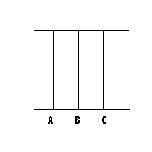How do I understand what people say? It seems like an impossible thing to do. Every day people utter sentences I have never heard before. And I take it all in and
understand them. Bizarre! The most natural explanation of this phenomenon is that I understand what each of the words mean
individually and I have some rudimentary understanding of how to
put them together to form sentences. But, come now, that can't be all there is to it! Let's see what the linguists have had to say about this.
Compositionality is the principle which states that the meaning of a compound expression is a function of the meaning of its parts
and of the syntactic rule by which they are combined. It is this second part which carries most of the import.
Even in purely logical endeavors, the situation is not cut and dry. For instance, in the substitutional interpretation of classical predicate logic, one can derive (∀ x)φ(x) from φ(a), where a is arbitrary. This
breaks compositionality. That is, how is one to find the correct interpretation of (∀ x)φ(x) given only one φ(a)? One possibility is to add an infinitary rule, which essentially identifies the universal quantifier with an infinite conjunction. This proposal suggests to me that something like descriptive set theory may be useful, wherein hierarchies of sets correspond to suitable classes of first order sentences.
Not every linguist is too chuffed with compositionality and many counterexamples have been proposed. However, for the most part, these can be dealt with by modifying and/or enriching the syntactic aspect. One of the objections is sentences such as the following:
(1) Joseph said that a child had been born who would become ruler of the world.
Sentence (1) is ambiguous. That is, will the child become ruler of the world in the future of Joseph or in his past? Both are possible. One of the most interesting approaches to dealing with this is similar to how one deals with de dicto/de re ambiguities. That is, one invokes the following:
(*) Different possible interpretations of a sentence correspond to different derivations.
"Derivations" here is taken to mean something along the lines of a derivation in a
categorial grammar. Or, say, in parsing. This is quite appealing and is a good motivation for studying
isomorphisms of derivations. That is, one would like a natural notion of isomorphism, wherein isomorphic derivations correspond to the same interpretation of a sentence. Is it possible that breaking derivations up into isomorphism classes deals with ambiguity? This does seem like a plausible notion, though one would have to assess the actual notion of isomorphism before being fully convinced.
So, are there sentences which are not compositional? Well, if so, then they would be very odd sentences indeed. That is because every recursively enumerable language can be generated by a
compositional grammar. Unfortunately, the way this works is to pick and choose your particular grammar. Not so nice. As a result, one will always eventually run into trouble when using a
particular compositional grammar.
So, one possible explanation of how I understand what you say is that I am very good at picking the correct compositional grammar to use in the correct situation. Or, more likely, I have evolved a particular grammar that works quite well in most situations. This is evidenced by the fact that I, like all other children, probably uttered a sentence such as:
(2) I seed two mans
The problem with (2) is, of course, that whatever grammar I was using at the time was a bit too weak and had rules for changing the tense and for pluralising that are not always correct. I'm a bit better at doing these things now...
(The technical parts of this post are mainly based on T.M.V. Janssen's article in The Handbook of Logic and Language)


